Brancaster Chronicle No.59: Alexandra Harley Sculptures
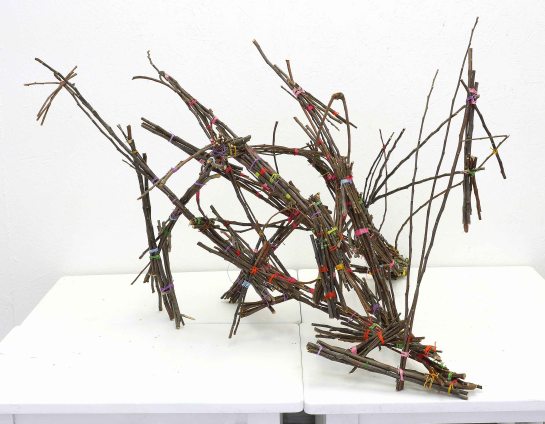
Brindille, 2018, h74cm w115cm d110cm, wood and thread
15th July 2018, near King’s Lynn.
Taking part: Alexandra Harley, Anne Smart, Anthony Smart, Robin Greenwood, Sarah Greenwood, Hilde Skilton, Mark Skilton, Noela James, Steven Walker, Edward Pile, Richard Ward, John Pollard
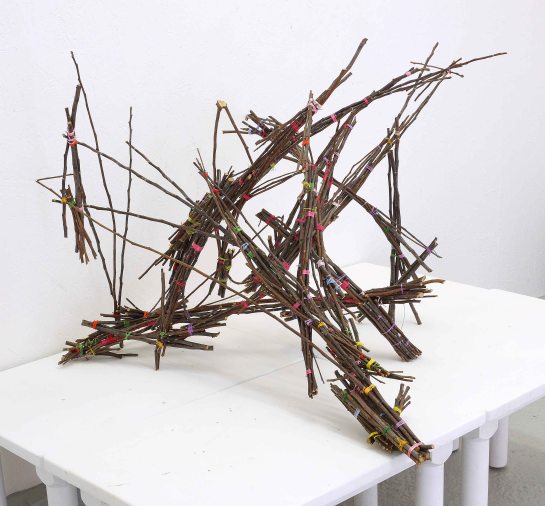
Brindille, 2018, h74cm w115cm d110cm, wood and thread [view 2]
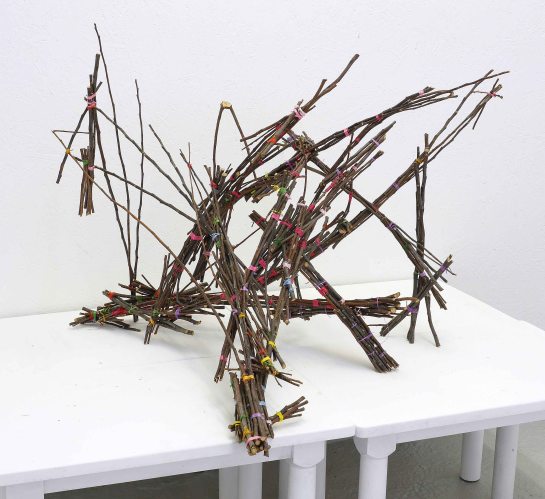
Brindille, 2018, h74cm w115cm d110cm, wood and thread [view 3]
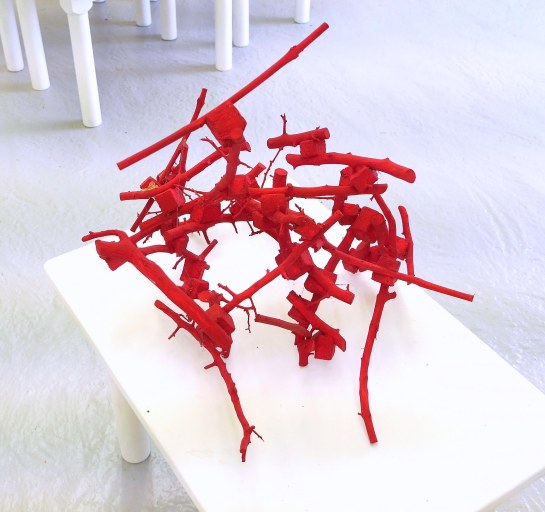
Billig Red, 2018, h42cm w59cm d51cm, ceramic and wood
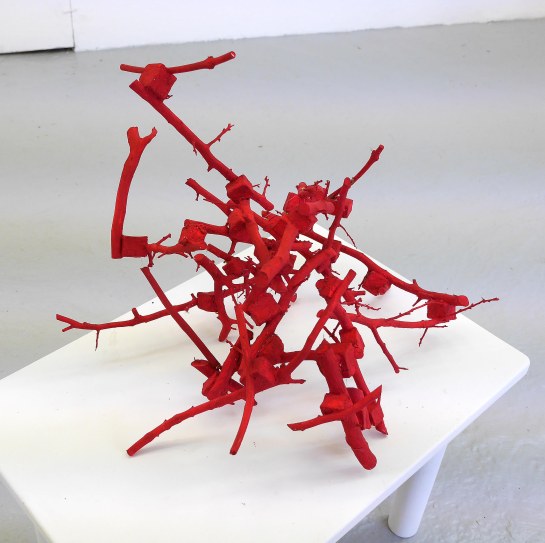
Billig Red, 2018, h42cm w59cm d51cm, ceramic and wood [view 2]
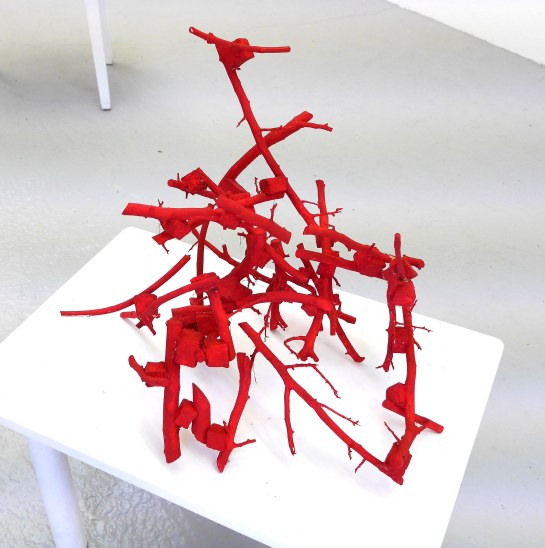
Billig Red, 2018, h42cm w59cm d51cm, ceramic and wood [view 3]
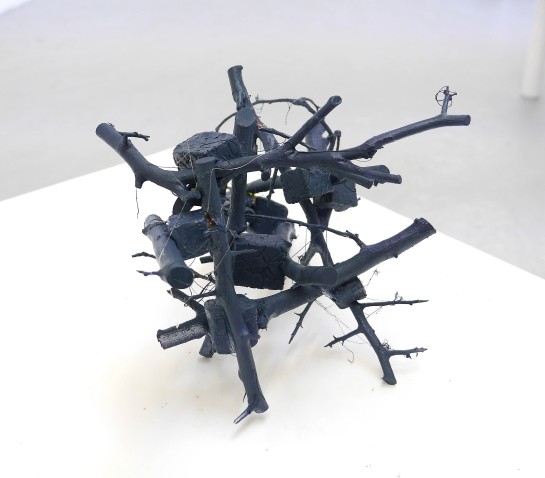
Billig Blue, 2018, h28cm w37cm d25cm, ceramic and wood
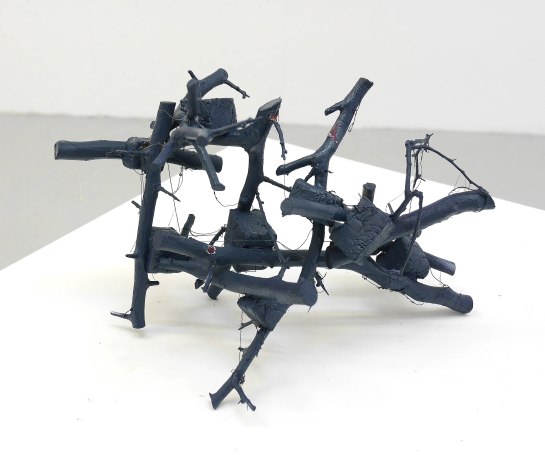
Billig Blue, 2018, h28cm w37cm d25cm, ceramic and wood [view 2]

Billig Blue, 2018, h28cm w37cm d25cm, ceramic and wood [view 3]
Billig red, what a beautiful work. A wonderful combination of natural material and ceramic. It has an energy and a life of its own. A very clever way of introducing dynamic juncture.
LikeLiked by 1 person
Hi Alex
If ever you feel in need of a ‘bit of a boost’ just watch your film !
Everyone there is ,and remains enthralled by your sculptures and intelligent discourse abounds!
I wondered how your sculptures ‘sit’ in the current sculpture debate.
The applewood piece is the most relevant.
For me even though I love the small pieces I think they are unified by the final application of the paint.
In the applewood piece the actual interdependence of the pieces and parts means its not possible to take a part away, [ as was suggested in Marks ] ,and this could be what, in the ‘background’ of one’s my ,makes it whole.
PS …pleased you did not paint it .
Anne
LikeLiked by 1 person
….a further thought….
The paint coat in the two small pieces in unifying the organic material releases the form of the twig into an illusionary world of movement .
The applewood piece ,not painted, remains as actually bent and actually poking out and actually tied and does not cross over into illusion.
What does this mean?…….
LikeLiked by 1 person
Hi Anne, I rather like the idea of the painted pieces taking the viewer into ‘an illusionary world of movement’. For me the paint is unifying in a good way. Whilst I really admire the way ‘Brindille’ is structured I feel a little distracted by the materiality and can’t ‘see’ it so clearly. The paint brings visual clarity to my eyes.
I think Alex has such an inventive and inspirational command of diverse materials, (see other Brancasters) I feel she could make sculpture out of anything.
LikeLiked by 1 person
….a further further thought !
This must ask the question…what has been the purpose of painting [ usually steel ] sculpture ?….and quite what kind of illusion was being sought by the artist back then ?
Has wholeness been thought of as an illusion?
Has a paint coat been seen as giving steel a’ sculptural’ status.?
LikeLiked by 1 person
Sculpture, historically has often been painted, early Greek and Roman were to our eyes quite gaudy. I had expected/planned to paint all of these. The Billigs needed bringing together, the original colours were too distracting and I wanted to minimise the material contrast and to focus on the structure. Does paint create a ‘finish’? Does painted sculpture now feel that it creates clarity. Does the same thing happen with weathered metal.
LikeLike
Good points Noela
Some people would say that a single aspect of a sculpture or painting [ abstract] which brings everything together is too simple and the work’s ‘complexity and variety’ should be able to achieve that resolution [ but that may not be simple ] ?
LikeLiked by 1 person
Yes, I think the complexity and variety is still very evident in Alex’s sculptures even though the paint brings everything together.
LikeLiked by 1 person
Only seeing these sculptures as photographs, I enjoyed the combination of abstract and natural. There is no doubt in my mind, that these are abstract sculptures, but the natural growth offers structure and openness that would not be achieved with metal. And if you did, the abstract purists would decry it as offering realism. Looking back through previous Brancaster shows, I find these the most successful. The paint, adds an abstract quality, while component shapes still echo representation. Previously, unpainted natural materials, for me, fought more against the abstract. I am not an abstract purist, whereas most contributors to the Brancaster Chronicles are, I am very happy seeing abstraction rather than fully abstract. Even in Brindille, the coloured thread kept my eyes moving around, joining together those of the same colour. They held my interest, but my eyes focussed on the threads more than the whole.
LikeLiked by 1 person
Hi Alex, I have been wondering if you would be able to use technology to cast or enlarge these sculptures you have made.
LikeLike
There is no denying the use of natural materials in these sculptures.
There is no denying that fired clay,formed into junctions for the wood,and that painting of the whole to neutralise one aspect at least of that naturalness is happening. [I had to be told that the junctions were fired clay ?]
What I think is interesting in these sculptures is how the material of each sculpture comes together in their individual combinations.
The question in the end is wether what is achieved goes beyond a love of the natural world, a dependance on what we already know, or something in this combination that is an invention !
LikeLike
Hi Noela
This is not an answer to your question to Alex.
My question to you …do you think anything could be gained by enlarging these sculptures.?
LikeLike
I really enjoyed looking at Alex’s sculptures. The two sculptures that I enjoyed most, Billig Red and Brindille, have a clarity and organisation that makes them clear to read although I wouldn’t call them simple. Both the shape of the parts and the space in between the material seem relevant with a kind of remarkable precision. Relationships between parts seem appropriate as well. Brindille did remind me of last year’s Untitled wood sculpture. On the plus side they both have this elegance, a smooth movement, almost a sweep across space. This might be their limitation though, as I come back to reading them the same way. Ideally I like a sculpture to disrupt simple movement while still having clarity and making sense in its internal relationships.
Perhaps Billig Red does this better than Brindille, the only part of which I got stuck on was the horizontal(ish) top which seemed to repress the rest of the sculpture somewhat.
LikeLike
Hi John, I see what you mean but, looking again, I feel the top of Brindille tends to contain rather than repress, it sets a boundary which creates a dynamic that offsets the movement within the work.
LikeLike
Hi Tony, I have been wondering this myself. There may not be more to gain other than size. Would casting or enlarging take something away? I rather like the idea of seeing them large, in an appropriate space.
LikeLike
John
I agree with most of what you say.
I too am thinking ,in my memory, that the red sculpture of Alex’s might be better than the apple wood sculpture.
I think I said that nothing could be taken out of it.[ the apple wood piece ]. Well maybe its ‘literal’ interdependency is taking its toll.
This point corresponds with your observation of a lack of disruption, and if I am understanding you correctly, I had previously raised the question of contradiction. As these are only words we may be speaking of a lack of the same thing ? What made me consider this was your description of ‘sweeping’ .
I would have to add that because now the sculptures of Robin and Mark and Alex are all memory, I am beginning to get a clearer picture across all three of them. I see their works coming to terms with their individual ambitions and I see that as a separating and divergent force.
LikeLike
Noela.
I would just say in response to your question that [ in my opinion] these sculptures are constructions and much of any construction’s vitality and ‘character’ or reality is dependant on being just that, a construction.
So call me a purist all day long , I can’t see reason to enlarge or copy in any way.
Also, as everything is felt and understood, given meaning and achieves wholeness,I can’t understand the addition of a paint coat after the event. Why not paint the stuff before you start?…or as you are going during construction?
LikeLike
Tony,
“…because now the sculptures of Robin and Mark and Alex are all memory, I am beginning to get a clearer picture across all three of them. I see their works coming to terms with their individual ambitions and I see that as a separating and divergent force.”
What’s the significance of this? I ask because I see something of a trend in both Mark’s discussion and this one to view some of the work’s idiosyncrasies and/or novelties as positives. Maybe, but I’m not so sure, and whilst I agree that all the sculptors are making there “own” work, I don’t see that being necessarily a part of the work’s ultimate value.
LikeLike
Robin.
I have made some observations about the work , across all three sculpture Chronicles to date.
I would be surprised if by this point in our lives we were not ever more particularising themes even though the work itself may always carry common concerns.With a more individual sculpture comes a much more interesting and challenging environment and ultimately so also for the future of all Chronicles debates. The ‘ ultimate value’ will emerge from whatever conditions the artists feel most motivated by and with their own individual freedoms.
I have just challenged the issue of painting sculpture as an afterthought,fully aware that others will see that as blinkered or whatever!
But I like what you are saying and would happily discuss idiosyncrasies or novelties in respect of the issues in the work.
For the sake of this debate, and to be clear, what are these idiosyncrasies and novelties you are thinking of.
Are they behavioural or things?
LikeLike
Tony,
As we see all around us in the art world, individual freedoms can quickly come to be pointless cul-de-sacs. I’d rather talk about freedoms won for sculpture, not individuals. Likewise, I’d rather talk about the intentionality of the work than the intentions of the artist. But don’t misunderstand me – I think on the whole it is good that our sculptures are more and more different and varied in what they are taking on, so long as they address issues that are genuine to sculpture. In that regard, even if our assessment of value is only provisional, as it no doubt must be, it’s an important distinction to make between the literal and the illusionistic.
Perhaps with Alex the use of twigs has now gone beyond novelty, but in these three works I see the decision to use this material as problematic. The twigs here have a start point at A, and travel in a linear direction, to point B, where they come to an abrupt end. That in itself I see as problematic for abstract sculpture that aspires to three-dimensionality, and takes the problem no further than when we encountered something similar in the “bandsaw” sculpture last year. In two of these sculptures, the twigs have branching geometry, but that seems quite as literal as the linearity. Despite their “off-piste” character, I think as sculpture they are somewhat conventional (maybe that was hinted at by your own reference to Caro’s “Month of May”?) and “undercooked”.
The “project” is, according to Alex, about how to join things together (though we all do that), in this case with things that are not easily joined, and so in two cases we have ceramic inserts to accommodate a junction. I find that rather perfunctory, and as has been hinted at, the paint takes away the reality of that construction methodology anyway. It is certainly not a “developed” idea, or a particularly exciting sculptural solution. I’m not even sure that the project of joining stuff is necessarily sculptural. I feel thus that we are thrown back upon the idiosyncrasies.
LikeLike
Robin.
In my opinion nobody is going to sign up for………………..”so long as they address issues that are genuine to sculpture.”
HOW? and WHO? and WHEN?
LikeLike
Robin.
I read your critique on Alex’s work in the hope that I would find in your latent contribution something positive against a film which I think of as one of the best we have done.
This could not have happened without the work being much much more than you think it is. The great pity for the Chronicle was that you were not able to say all of this on the day and in so doing would have made the experience even richer and made me work harder work which I would have loved. I rather think that the consensus was pro the sculpture and I still feel looking at Alex’s sculptures and particularly at the apple wood piece that you just don’t ‘get’ it .
I have been totally specific in the film full on ,fully engaged. And as for ‘junctions’ and ‘lengths’ not being three dimensional or sculptural that does rather leave construction looking a bit limp.
Be careful what you wish for !
I do think, wether you like it or not, this sort of approach to sculpture,using makeshift materials and inventive thinking is a positive way forward. [ in my opinion].
It certainly makes me really think.
I do still think they are ‘undercooked’. I can sense there is a lot of room in this project.
LikeLike
You seem a bit preoccupied with how good the film is. To be honest, I haven’t given it any thought.
The thing I’d most like to know at the moment is what Alex now thinks about these three sculptures.
LikeLike
Yes I quite agree….me too.
LikeLike
I was just thinking about the exchange between John and Noela regarding the bit across the top in Billig Red when I saw this tweet by Sam of a Tim Scott.
Anyone see a connection? Not just in this, but across a number of Tim’s works and how they are put together?
LikeLike
Yes
I like where you are going with this Noela……..[ where you reply to John Pollard ]
…and for me it raises the question of whether the containing you refer to is of the space, the movement or both.
I have been wondering why little has been said about space and I am particularly thinking of space in respect of this piece
[ the apple wood piece]
If the material can be described as idiosyncratic why…is it just the material and how it is handled or is the space an inevitable part of that handling?
So what we have is a very intuitive sculpture where the bravado of the material is being literally criticised.
What sort of space has this intuitive fast construction created?
LikeLike
Robin
What is the date of the Tim sculpture?
and..sorry you will have to explain the similarities
I can understand how the Tim Scott works but don’t get the similarity.
LikeLike
…check out ‘Steel Sculpture part two ‘ for another view of this sculpture ..its weird what it becomes in this other view!
LikeLike
I’m working on it, but can’t find the right photos… meanwhile, how about the “Song for Rhythm” series and “Billig Red”, or how about “Feminine for Structure VII” and “Brindille”. Look at how they stand in the world, look at how the parts float together or past each other, look at how non-spatial is the thinking!
LikeLike
Noela,
Apologies for not being clear enough: I meant the ‘bar’ at the top of Billig Red not Brindille.
I’m not sure ‘contains’ is a positive descriptive term, at least not generally, in sculpture. Maybe this is because I believe every aspect of a work of art needs to be active and meaningful, while I think you enjoy passive inactive areas that are used to make other parts of a work active?
LikeLike
Robin
if possible could you send a link to the pieces of Tim’s you refer to…I can’t find them .
LikeLike
well, if I could find the pics online, I’d publish them… I’m looking at books. You remember… those things with pages made out of paper, and a bit of cardboard on the outside…
LikeLike
Whilst thinking about Alex and Tim… a question. Do you think (all) these three sculptures have wholeness?
LikeLike
I have no idea what you mean by wholeness, it sounds like you are suggesting they are unfinished
LikeLike
John, what I see in Brindille is kind of flattening which is created by the space, if that is possible. From one angle the elements seem to stop at a particular height, creating a ‘virtual’ flattening. The top ‘bar’ in ‘Billig Red’ echoes other bars within so for me there is an emphasis on rhythm flowing down through the whole work.
LikeLike
Tony, I feel the fast space, movement in ‘Brindille’ is almost increased by the material, but I don’t know why.
LikeLike
I actually liked Billig Blue the best, though it´s hard to say why. Maybe I was more concentrated on the “stuff” than on the space. I get the impression that in these works the space is energised rather than incorporated – activated by the sculpture but not made an intrinsic part of it and maybe also not articulated by it, if that makes any sense. The way that an area of background in a painting can be activated and made positive without losing its background quality (think Rembrandt). Or the way that the wall around John Bunker´s collages can be activated without being articulated.
LikeLike
There isn’t a definition of wholeness . It changes with the expectations of the particular piece.
This won’t be there for everyone either as the wholeness depends on one’s ability to see how a piece works.
It may reveal itself over a period of time, or never.
It should be an amalgamation of all the elements of the particular piece or enough of them for you to feel the piece convincing.
I would’t have thought that the same elements would necessarily be present, it surely would vary on what sort of sculpture it is and when it is made. I am only saying this about wholeness because without some introduction what I feel about the three pieces would be meaningless and even so this is far from complete. It is a huge subject.
The larger applewood piece, I have said is a whole piece, and that nothing can be taken from it, whereas with the two smaller pieces the red one is compromised I feel at its top, as I think I have already said, and I am suspicious of the paint as I am with the blue piece.This piece doesn’t have enough going on in it and that for me would be a necessity for wholeness, its level of ambition. But they are still good pieces.
So you can see from this the difficulty of trying to pin down something which is in a state of flux as is everything we seem to be discussing, and as ever I reserve the right to change my mind.Changing your mind is not fickle like some sort of novelty or an idiosyncrasy of making art ,it is thrust upon you by discovery which is one of the really big reasons I make art anyway.
LikeLike
Noela
All that physical handling of the material, the bundling, bending, chopping, tying, teasing open, propping, etc will vary how one perceives and feels this sculpture right down to the loose ends that sometimes define the pace and the space all working together ,but not necessarily all singing from the same hymn sheet.
And as Richard has just said the space [ of which not much has been said ] ” is activated not articulated”.
That is just a small something to your question but I feel much could be said about this piece but one would have to be in front of it .
LikeLike
Hi Alex,
Thanks for your reply. I didn’t make any comment about wholeness or ‘unfinished’ in relation to your work, I merely asked the question. It’s a topic I’d really like to return to, but perhaps when we have Tony’s work up. Both you and Hilde have now said you don’t know what wholeness is, and neither do I, in the sense that I can’t define it. I agree with Tony on that, although Anne has had a stab at it in her very first comment. But I think its a really important and interesting thing to try to talk about.
I like Richards comment about the particular relationship of your work to space, and I do actually think that that relates to Tim’s work too. However, nobody has seemingly got the connection with Tim, so I might drop it unless you have any thoughts on it.
LikeLike
Robin
No. Let’s not drop the Tim/ Alex thing you have brought up.
You seemingly get the connection, so you having introduced this, should continue. The floor is yours.
LikeLike
oh thanks. Two problems – lack of photos and I was hoping for some help, but I’ll have a go. Will get back on it. Still hoping Alex might chip in on it. Maybe we can get back into it through your work which is now up.
LikeLike